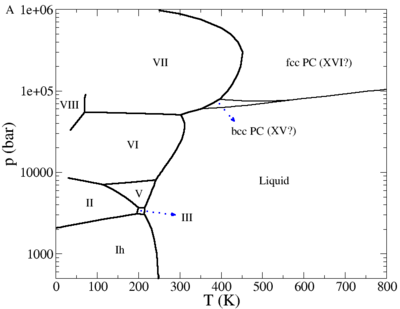TIP4P/2005 model of water: Difference between revisions
Carl McBride (talk | contribs) m (Slight tidy) |
Carl McBride (talk | contribs) m (Added location of the liquid-liquid critical point) |
||
| Line 41: | Line 41: | ||
==Shear viscosity== | ==Shear viscosity== | ||
The [[shear viscosity]] for the TIP4P/2005 model is 0.855 mPa.s at 298 K and 1 bar <ref>[http://dx.doi.org/10.1063/1.3330544 Miguel Angel González and José L. F. Abascal "The shear viscosity of rigid water models", Journal of Chemical Physics '''132''' 096101 (2010)]</ref> (experimental value 0.896 mPa.s <ref>[http://dx.doi.org/10.1021/je049918m Kenneth R. Harris and Lawrence A. Woolf "Temperature and Volume Dependence of the Viscosity of Water and Heavy Water at Low Temperatures", Journal of Chemical & Engineering Data '''49''' pp. 1064-1069 (2004)]</ref>). | The [[shear viscosity]] for the TIP4P/2005 model is 0.855 mPa.s at 298 K and 1 bar <ref>[http://dx.doi.org/10.1063/1.3330544 Miguel Angel González and José L. F. Abascal "The shear viscosity of rigid water models", Journal of Chemical Physics '''132''' 096101 (2010)]</ref> (experimental value 0.896 mPa.s <ref>[http://dx.doi.org/10.1021/je049918m Kenneth R. Harris and Lawrence A. Woolf "Temperature and Volume Dependence of the Viscosity of Water and Heavy Water at Low Temperatures", Journal of Chemical & Engineering Data '''49''' pp. 1064-1069 (2004)]</ref>). | ||
==Liquid-liquid critical point== | |||
For the TIP4P/2005 model the [[Liquid-liquid phase transitions | liquid-liquid]] [[critical points | critical point]] is located at <math>T_c = 193</math>K, <math>p_c =1350</math> bar and having a density of <math>\rho_c =1.012</math> g/cm<sup>3</sup> <ref>[http://dx.doi.org/10.1063/1.3506860 José L. F. Abascal and Carlos Vega "Widom line and the liquid–liquid critical point for the TIP4P/2005 water model", Journal of Chemical Physics '''133''' 234502 (2010)]</ref>. | |||
==References== | ==References== | ||
<references/> | <references/> | ||
Revision as of 12:00, 20 December 2010
The TIP4P/2005 model [1] is a re-parameterisation of the original TIP4P potential for simulations of water. TIP4P/2005 is a rigid planar model, having a similar geometry to that of the Bernal and Fowler model.
Parameters
The TIP4P/2005 model consists of a Lennard-Jones site for the oxygen atom, and three charge sites.
| (Å) | HOH , deg | (Å) | (K) | q(O) (e) | q(H) (e) | q(M) (e) | (Å) |
| 0.9572 | 104.52 | 3.1589 | 93.2 | 0 | 0.5564 | -2q(H) | 0.1546 |
Phase diagram
The phase diagram of the TIP4P/2005 model in the pressure-temperature plane (adapted from Fig. 9a of [2]) is given in a publication by Abascal, Sanz and Vega [3]
and for negative pressures in the publication [4]
Liquid-vapour equilibria
Plastic crystal phases
Recent simulations have suggested the possibility of a plastic crystal phase or phases for water [2][6]
Surface tension
The surface tension has been studied for the TIP4P/2005 model [7] [8] [9]
Self-diffusion coefficient
The TIP4P/2005 potential has a self-diffusion coefficient, in bulk water at 298 K, of 0.21 Å2 ps−1 in a classical simulation of 216 water molecules (experimental value: 0.23 Å2 ps−1) [10].
Shear viscosity
The shear viscosity for the TIP4P/2005 model is 0.855 mPa.s at 298 K and 1 bar [11] (experimental value 0.896 mPa.s [12]).
Liquid-liquid critical point
For the TIP4P/2005 model the liquid-liquid critical point is located at K, bar and having a density of g/cm3 [13].
References
- ↑ J. L. F. Abascal and C. Vega "A general purpose model for the condensed phases of water: TIP4P/2005", Journal of Chemical Physics, 123 234505 (2005)
- ↑ 2.0 2.1 J. L. Aragones and C. Vega "Plastic crystal phases of simple water models", Journal of Chemical Physics 130 244504 (2009)
- ↑ Jose L. F. Abascal, Eduardo Sanz and Carlos Vega "Triple points and coexistence properties of the dense phases of water calculated using computer simulation", Physical Chemistry Chemical Physics 11 pp. 556-562 (2009)
- ↑ M. M. Conde, C. Vega, G. A. Tribello, and B. Slater "The phase diagram of water at negative pressures: Virtual ices", Journal of Chemical Physics 131 034510 (2009)
- ↑ C. Vega, J. L. F. Abascal and I. Nezbeda "Vapor-liquid equilibria from the triple point up to the critical point for the new generation of TIP4P-like models: TIP4P/Ew, TIP4P/2005, and TIP4P/ice" Journal of Chemical Physics 125 034503 (2006)
- ↑ J. L. Aragones, M. M. Conde, E. G. Noya and C. Vega "The phase diagram of water at high pressures as obtained by computer simulations of the TIP4P/2005 model: the appearance of a plastic crystal phase", Physical Chemistry Chemical Physics 11 pp. 543- (2009)
- ↑ C. Vega and E. de Miguel "Surface tension of the most popular models of water by using the test-area simulation method", Journal of Chemical Physics 126 154707 (2007)
- ↑ José Alejandre and Gustavo A. Chapela "The surface tension of TIP4P/2005 water model using the Ewald sums for the dispersion interactions", Journal of Chemical Physics 132 014701 (2010)
- ↑ J. M. Míguez, D. González-Salgado, J. L. Legido, and M. M. Piñeiro "Calculation of interfacial properties using molecular simulation with the reaction field method: Results for different water models", Journal of Chemical Physics 132 184102 (2010)
- ↑ Thomas E. Markland, Scott Habershon, and David E. Manolopoulos "Quantum diffusion of hydrogen and muonium atoms in liquid water and hexagonal ice", Journal of Chemical Physics 128 194506 (2008)
- ↑ Miguel Angel González and José L. F. Abascal "The shear viscosity of rigid water models", Journal of Chemical Physics 132 096101 (2010)
- ↑ Kenneth R. Harris and Lawrence A. Woolf "Temperature and Volume Dependence of the Viscosity of Water and Heavy Water at Low Temperatures", Journal of Chemical & Engineering Data 49 pp. 1064-1069 (2004)
- ↑ José L. F. Abascal and Carlos Vega "Widom line and the liquid–liquid critical point for the TIP4P/2005 water model", Journal of Chemical Physics 133 234502 (2010)
Related reading









